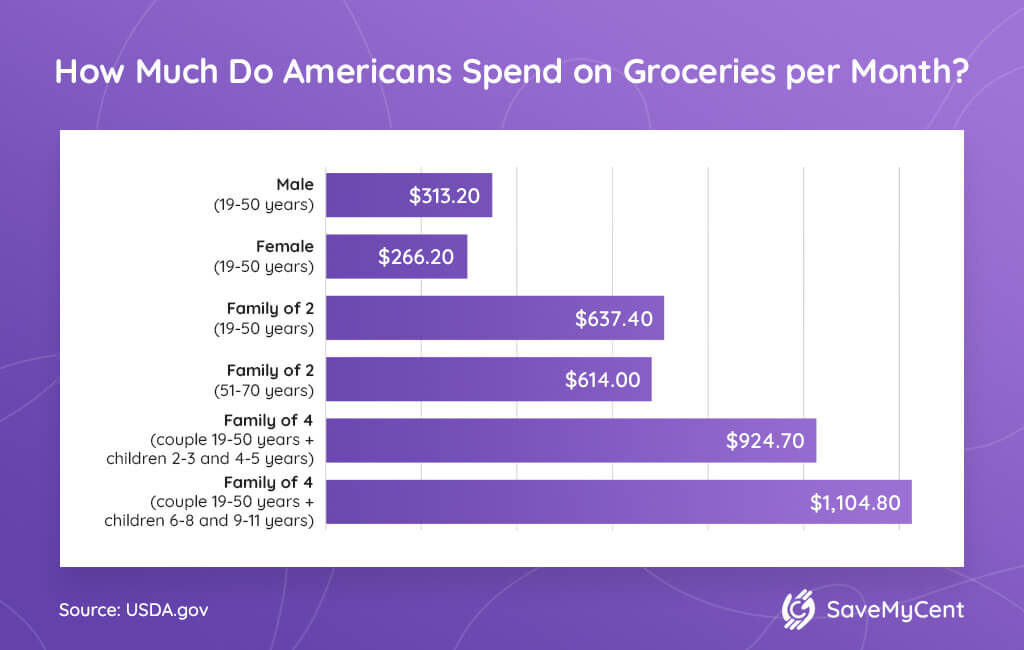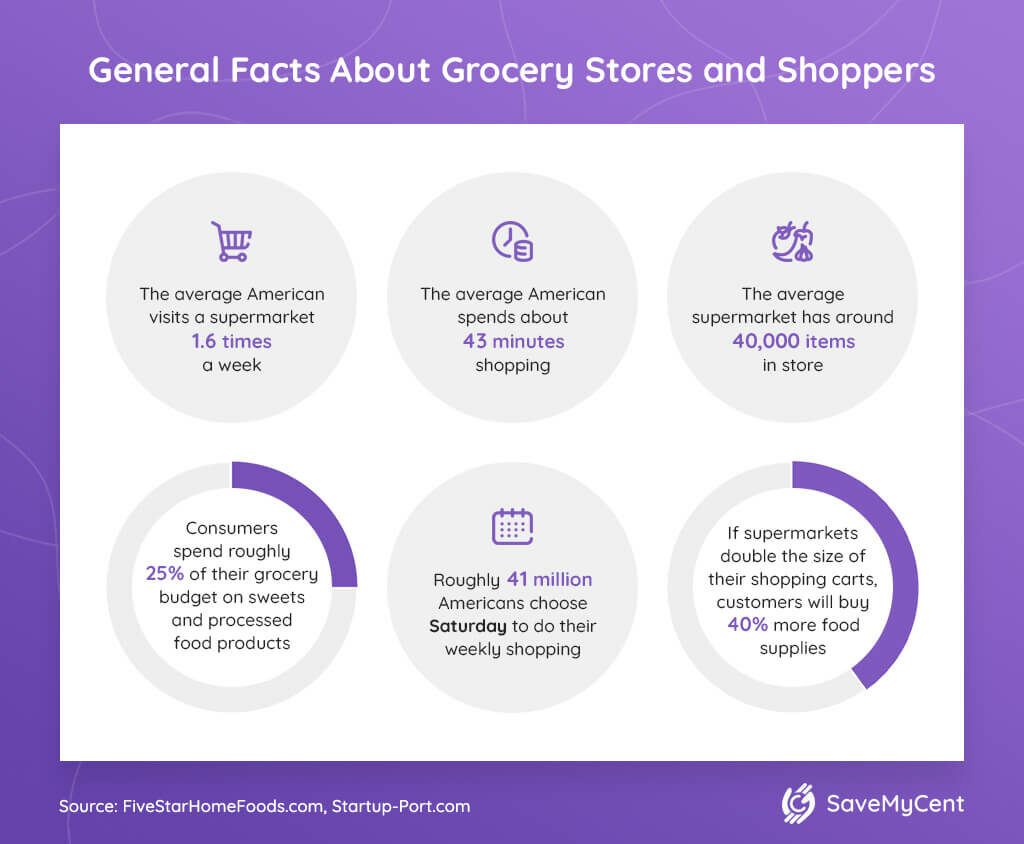Have you ever dreamed of going grocery shopping? If you have, you should know that this dream symbolizes your desire to feel alive. So, the groceries in your dream represent items that you need to sustain life.
Anyhow, shopping for groceries is something that no one can skip. For most people, it’s dull, repetitive, and a drag. But, you gotta do what you gotta do to put food on your table.
Most of us go grocery shopping at least once a week. Grocery shopping statistics show that we mostly do so on weekends. So, Saturdays and Sundays are always busy in American grocery stores.
The US grocery store industry is gigantic. Americans are big consumers, and they invest a lot of money in their food budget. However, there are big differences in how much money each section of the population can spend on food supplies.
So, if you’re curious to find out about the latest grocery shopping facts and statistics in the US, you’ve come to the right place. We’ve gathered them all in a neat package for you.
Delicious Grocery Industry Trends (Editor’s Choice)
- People spend around 60 hours doing grocery shopping on a yearly basis.
- Shopping on weekends can be hard since these are the busiest days for supermarkets.
- It is more expensive to have you groceries delivered to your home address.
- Thanksgiving grocery shopping statistics say that the Tuesday before Thanksgiving is the worst day to go food shopping.
- Couples who share a home spend approximately $637 per month for groceries.
- A typical US family of four with older kids spends $1,104 per month on food and groceries.
- The average American visits a supermarket 1.6 times a week and spends about 43 minutes shopping.
- In 2021, the US supermarkets and grocery market size was expected to reach $658.1 billion.
General Grocery Store Statistics
1. In 2020, the price of food-at-home rose by 3.9%, which is 75% more than in the previous year.
(U.S. Bureau of Labor Statistics)
Americans are spending more and more money on food. While rising prices account for some of that, people are also eating more organic food, which is healthier and more expensive.
2. Couples who share a home pay approximately $637 per month for groceries.
(USDA)
When you couple up, you double your grocery costs. So, middle-class couples spend around $7,600 per year.
On the other side, when partners decide to relax and not cook, they spend 4.5% of their pay on eating out.

3. A typical family of four with older kids spends $1,104 per month on food and groceries.
(USDA, CreditDonkey)
If you intend to start a family, you should expect your expenses to go up considerably. Once you have a baby, you’ll need to spend about $901 for food per month, grocery shopping statistics confirm.
4. American households spend around 10% of their income on food supplies.
(CreditDonkey)
In contrast, in 1900, families spent around 40% of their income on groceries. This percentage decreased by 10% by the 1950s. Stats from 2013 say that the average American household used to spend about 10% of its budget on food. So, the amount of money Americans spend on food has gone down significantly.
5. According to grocery spending statistics, one-member American households had to spend $3200 dollars on groceries in 2020.
(USDA)
Naturally, one person earns less, so they need to be mindful of their expenses. A typical, four-member US family spends by far the most on edibles and food supplies― $13,257.
6. Californian couples spend around $6,527 on food products.
(CreditDonkey)
Californians need to set aside more money for groceries than other Americans. Their cost of living is already high, and the prices of groceries on their market don’t help.
7. Couples in the Midwest spend $5,587 per year.
(CreditDonkey)
Stats prove that people in the Midwest spend almost a thousand dollars less than Californians on groceries. But New Yorkers spend around two hundred dollars less than people living in the Golden State.
8. Larger households spend about $118 on groceries per week on average.
(Startup Port)
The weekly shopping list of single consumers costs half of that, or $60 a week.
9. Baby Boomers spend $296, Millennials $253, Gen X $323, Silent Generation $264 dollars on average per month.
(Startup Port)
According to this stat, Generation X members spend the most on groceries. If we take a closer look at grocery shoppers demographics, Millennials, surprisingly, take care of their eating habits and spend only $70 less on food.
10. Higher-income families spend three times more on food than low-income families.
(ValuePenguin)
Families with a $70,000 yearly income can afford to spend more money on food than those with low yearly earnings under $20,000. Well off households spend a large portion of their income, 45%, on eating out in restaurants.
Households with elderly members or kids spend less money on food than those aged between 25 and 64, grocery shopping volume statistics say.
Lower-income households predominantly eat home-cooked meals, so they spend around 70% of their budget on groceries and rarely dine out.
11. In 1913, a loaf of bread cost about 5 cents, while eggs set buyers back 37 cents per dozen.
(TheStreet)
Today, Americans spend almost 30% less on groceries than in 1900.
So, American grocery shopping habits have changed accordingly.
12. People with low incomes spend $2,582 on food supplies every year.
(TheStreet)
This grocery store statistic shows that Americans with low salaries need to pay close attention to their budgets. In order to make ends meet, they usually need to make financial plans for all life amenities. As a result, they do not spend as much on dining out, maybe around $1,500.
The most impoverished Americans spend even more money on groceries, $4,070. They tend to prepare their meals at home. Eating out is not a viable option.
People who earn around $30,000 a year have a grocery budget of around $3,700. Elderly statistics on grocery shopping show a similar trend because of their limited spending power.
13. Americans who make about $52,500 dollars a year spend roughly $4,000 on food supplies.
(TheStreet)
Interestingly, this bunch of average income earners spends almost $3,000 on eating out, statistics of grocery shopping confirm.
Those who make around $87,000 a year spend $4,893 on groceries and $1000 less on going out to eat.
14. Americans with high incomes of $190,000 spend $6,677 per year on food.
(TheStreet)
The wealthiest Americans invest a large sum of money in their groceries. They also visit special supermarkets with organic and healthy food options. Naturally, they like to be out and about and dine with their friends.
General Facts About Grocery Stores and Shoppers

15. The average American visits a supermarket 1.6 times a week and spends about 43 minutes shopping.
(Five Star Home Foods)
This stat shows that Americans are reasonable shoppers. They want their shopping to be fast and efficient – not time-consuming. So, they spend around 53 hours a year grocery shopping.
16. The average supermarket has around 40,000 items in store.
(Five Star Home Foods)
Consumers often buy stuff they don’t need. So, supermarkets cash in on their overstocking practices. With the average number of products in a grocery store this high, we end up buying more snacks or trying out new food products.
17. Consumers spend roughly 25% of their grocery budget on sweets and processed food products.
(Five Star Home Foods)
This stat proves that many people spend a lot of money on unhealthy food choices. Unfortunately, for many, this is not a guilty pleasure but the only way to put food on the table. Grocery shopping trends confirm that feeding an average American family of four often involves eating a lot of processed food because it is the cheapest choice.
18. Out of 85 randomly collected shopping carts, 72% tested positive for E. coli.
(Five Star Home Foods)
This disturbing stat does not come as a surprise. Many people visit supermarkets on a daily basis, which cannot make them the cleanest places in the world.
Even more shockingly:
Grocery stores are dirtier than public restrooms, statistics confirm. So, please keep this grocery store fact in mind next time you go grocery shopping!
19. If supermarkets double the size of their shopping carts, customers will buy 40% more food supplies.
(Five Star Home Foods)
Most consumers don’t notice when the shopping carts get bigger. Some grocery chains are so sneaky, they place carts in the middle of the store so that consumers who just dropped by to pick up a few things would reconsider and buy more.
20. Heading to the supermarket on the weekend will take more of your precious time.
(Startup Port)
Grocery stores statistics show that if you want to be time-efficient, you should do your shopping before the weekend comes. Getting in and out of a grocery store is easiest when you visit it on a Tuesday or a Wednesday.
21. Roughly 41 million Americans choose Saturday to do their weekly shopping.
(Startup Port)
The first day of the weekend is the most convenient for Americans who work from nine to five. They want to sleep in on Saturday and then take care of their groceries. This is why Saturday is the busiest grocery shopping day of the week.
So, if you want to shop and have some peace and quiet while you’re at it, maybe you should pick a Monday or a Tuesday. On these days, around 29 million consumers are out and about.
22. Grocery stores are busiest between 4 pm and 5 pm on weekdays.
(Startup Port)
According to this consumer grocery store industry statistic, many Americans tend to rush into the supermarket on their way home from work. Some people don’t do weekly or monthly grocery shopping, so they stop by for food supplies to make themselves dinner after a long day in the office.
On weekends, on the other side, grocery shops start to cram up with shoppers in the morning, between 11 and 12.
23. There are about 40,460 supermarkets in the US.
(IBISWorld)
This huge number of grocery stores in the US speaks volumes about American consumerism. 70% of these supermarkets are the typical grocery stores, while gourmet stores and supercenters make up the rest.
24. In the US, the average age of adult grocery store consumers is 44.
(Startup Port)
This stat shows that US supermarket consumers older than 18, are on average 50 years old. On the other hand, female consumers are three years older- 47, more or less.
25. 25% of US consumers prefer locally grown or organic food.
(Startup Port)
The healthy grocery shopping statistics prove that less than 30% of interviewed Americans are concerned about their food quality. With so many processed and sugar-saturated food products on the market, it’s difficult to eat and stay healthy.
But it’s not all bad news:
Some Americans pay special attention to ensure their food is grown and sourced locally.
Women vs Men Grocery Shopping
26. For 39% of American couples, men are in charge of grocery shopping.
(CreditDonkey)
This stat gives hope for the much-needed reshaping of traditional gender roles. Buying food and cooking used to primarily female chores. Nowadays, many couples split them or do everything together.
Splitting the supermarket duty between partners saves the cost of fuel and the time one person would normally need to do this chore.
27. 57% of female consumers collect coupons, women grocery shopping statistics reveal.
(Startup Port)
Even though most Americans are too shy or ashamed to use coupons when they shop, this is an effective strategy to save money.
Nevertheless, cutting grocery expenses by using coupons is more appealing to women. Only 41% of men are likely to clip coupons and use them in stores.
28. Almost 70% of female consumers take a shopping list to run their supermarket errands.
(Startup Port)
This is one of the grocery store facts that shouldn’t come as a surprise. The figure compares to 52% of men who make a supermarket grocery list. Younger men are more likely to do that.
However, it’s always a good idea to make a shopping list before you head out to the supermarket.
For one thing, it makes it easier to focus on the items you really need.
For another, it will save you time and money. Grocery store sales statistics point out that limiting yourself to the grocery list items will decrease your chances of reckless shopping.
29. Female shoppers need around 42 minutes to finish their grocery shopping.
(Startup Port)
Men spend three minutes less in supermarkets than women. The under 30 population’s average time spent grocery shopping is around 43 minutes.
30. In 2020, 25% of men claimed they changed the way they shop for groceries after the pandemic had started.
(Statista)
This statistic also shows that only 21% of women did the same. In another study, 35% of respondents of all genders said that they avoided certain times when shopping during the pandemic.
31. Male shoppers usually pick up predetermined items in grocery stores.
(Grocery Dive)
Women enjoy browsing supermarket aisles, while men are more focused on what they need. They plan their shopping trips ahead, get what they want, and go back, male vs. female grocery shopping statistics say.
32. Men predominantly buy meat and alcohol when they do their grocery shopping.
(Grocery Dive)
As stereotypical as it may sound, men’s shopping lists prioritize booze and meat. That’s how you end up with a fridge full of Bud Light and steaks.
Online vs Brick and Mortar Grocery Store Statistics
33. In 2020, 68% of Americans who expressed a high or moderate level of concern about the coronavirus opted for online grocery shopping.
(Statista)
Most Americans became more receptive to online shopping during the pandemic, online shopping and grocery store statistics confirm. This projected online grocery shopping forward by several years. Also, it showed the importance of having a versatile ecommerce strategy.
34. 83% of consumers prefer brick and mortar grocery stores, online grocery shopping trends show.
(CreditDonkey)
Clearly, people want to personally make sure their food’s fresh.
What’s more:
Americans are reluctant to purchase food online. They don’t want to risk paying for the delivery of groceries and yet still have to go to the supermarket should things go wrong with their order.
35. Statistics predict that the online grocery market size in the US will amount to $59 billion by 2023.
(Startup Port)
Researchers forecast a bright future for the online grocery market. In 2020, the online grocery market grew to $26 billion.
36. In 2020, Walmart and Amazon were the most successful online grocery suppliers.
(Startup Port)
Online grocery industry analysis confirms that both companies are great e-tailers.
Check this out:
Walmart gained a 22% market share in 2020, while Amazon wasn’t far behind. At the same time, more than 150 million Americans have obtained Amazon Prime subscriptions.
37. As of February 2020, the salary of a grocery store manager is $79,342, grocery shopping statistics reveal.
(Salary.com)
You can make plenty of money by managing a supermarket or a grocery store. The salary can amount to $88,000 depending on your education, experience in the field, or skills and certifications.
Cheap Supermarkets and Grocery Store Revenues
38. The US grocery store market size reached $685.1 billion in 2021.
(IBISWorld)
The food industry is the second largest, after the clothing industry. And researchers predict it will keep growing. This year, the US grocery store market will grow by 0.3%.
Clearly, Americans spend big bucks on groceries. Also, 65% of this gigantic sales profit comes from brick and mortar stores, grocery shopping statistics support.
39. Between 2015 and 2020, the market size of the US grocery stores industry increased by 1.4% per year, grocery industry statistics reveal.
(IBISWorld)
The food industry will always keep its ruling status. People will always need to put food on their tables, no matter how expensive it gets.
So, the US grocery market size will continue to grow by leaps and bounds.
Final Words
All things considered, the US grocery shop industry is going steady and gaining more and more profits by the day.
Even though the US faces an economic crisis, grocery chains and supermarkets will make sure food and drinks make their way to consumers. And grocery shopping statistics are there to prove it.
FAQ
Q: How often does the average person go grocery shopping?
An average person visits a supermarket or a convenience store 1.6 times a week. In 2020, the average number of items purchased at a grocery store rose by around 19%, as people went to the store less often and they bought supplies for longer periods of time.
Q: How many products are in a typical supermarket?
Supermarkets have more than 40,000 items on offer. Grocery chains make sure that they procure a plethora of different products that can satisfy their customers’ demands.
So, even though it’s nifty to have all these different items at your fingertips, sometimes all this diversity it may overwhelm you. What’s more, shoppers start buying things they don’t even need, impulse grocery shopping statistics say.
Q: What percent of grocery shoppers are female?
According to the Research Gate, 72.1% of grocery shoppers are female.
Married women cook more often than their husbands. So, they have better insights into what they need from the grocery store.
Q: What is the busiest day for grocery shopping?
The busiest day of the week to get your shopping done is Saturday. Most people rush to supermarkets after they get some sleep after a busy week at work. So, supermarkets have the most customers between 11 am and noon.
Q: How many grocery stores are in the US?
As of 2021, there were about 40,460 supermarkets in America. The average grocery store size is gigantic – 41,651 square meters.
Q: When is the best time to go grocery shopping?
The best time to do your grocery shopping is in the morning or early afternoon on Tuesday and Wednesday. There aren’t as many people around, and the shelves are fully stocked with edibles, especially fresh fruit and vegetables.
But grocery shopping statistics tell us most Americans have to work in the morning, so they get their shopping done on weekends. This is not the best time to go grocery shopping because the supermarkets are overcrowded.
Resources:


![39 Insightful Grocery Shopping Statistics to Tickle Your Taste Buds [2024]](https://savemycent.com/wp-content/uploads/thumbs_dir/27-Jewelry-Industry-Statistics-1-qbt0m2pl1yrlwpnyzuz8npbg1shhluh839biybx2yk.jpg)
![39 Insightful Grocery Shopping Statistics to Tickle Your Taste Buds [2024]](https://savemycent.com/wp-content/uploads/thumbs_dir/14-Online-Reviews-Statistics-1-qbt0ze39vgzudubn8m6yzccj0auonhcbx615pg6at8.jpg)



![How to Get Free Clothes From Shein? [2024 Guide]](https://savemycent.com/wp-content/uploads/2023/09/How-to-Get-Free-Clothes-From-Shein-336x220.png)
